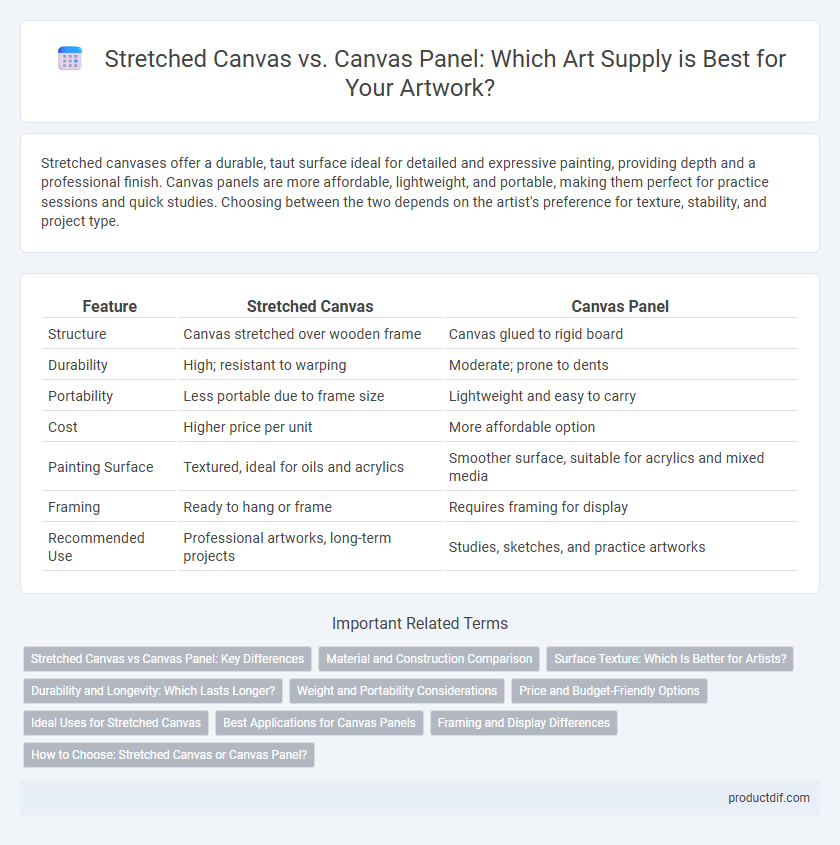Stretched canvases offer a durable, taut surface ideal for detailed and expressive painting, providing depth and a professional finish. Canvas panels are more affordable, lightweight, and portable, making them perfect for practice sessions and quick studies. Choosing between the two depends on the artist's preference for texture, stability, and project type.
Table of Comparison
| Feature | Stretched Canvas | Canvas Panel |
|---|---|---|
| Structure | Canvas stretched over wooden frame | Canvas glued to rigid board |
| Durability | High; resistant to warping | Moderate; prone to dents |
| Portability | Less portable due to frame size | Lightweight and easy to carry |
| Cost | Higher price per unit | More affordable option |
| Painting Surface | Textured, ideal for oils and acrylics | Smoother surface, suitable for acrylics and mixed media |
| Framing | Ready to hang or frame | Requires framing for display |
| Recommended Use | Professional artworks, long-term projects | Studies, sketches, and practice artworks |
Stretched Canvas vs Canvas Panel: Key Differences
Stretched canvas features a fabric tightly wrapped around a wooden frame, providing a flexible, textured surface ideal for oil and acrylic painting, while canvas panels consist of canvas glued to a rigid backing, offering portability and affordability. The key differences include durability, with stretched canvases generally lasting longer and allowing for better paint absorption due to their tensioned surface, whereas canvas panels are less prone to warping but may degrade faster over time. Artists often choose stretched canvas for gallery-quality works and canvas panels for studies or practice pieces due to these distinct structural and functional qualities.
Material and Construction Comparison
Stretched canvas features a high-quality cotton or linen fabric tightly pulled over a wooden frame, providing a flexible and durable surface ideal for oil and acrylic painting. Canvas panels consist of the same canvas material mounted on rigid, lightweight cardboard or hardboard, offering a cost-effective and portable alternative with less texture depth. Both options use primed surfaces, but stretched canvas generally allows for greater longevity and a more professional, textured finish due to its sturdy wooden stretcher bars.
Surface Texture: Which Is Better for Artists?
Stretched canvas offers a textured surface with natural weave and tension, ideal for artists seeking depth and brushstroke visibility, while canvas panels provide a smoother, more rigid surface that enhances detail work and ease of transport. The choice depends on artistic style: impasto painters often prefer the pronounced texture of stretched canvas, whereas illustrators or fine-detail artists might favor canvas panels for their flat, even surface. Both surfaces hold acrylic and oil paints well, but stretched canvas generally offers greater durability for long-term or gallery-quality pieces.
Durability and Longevity: Which Lasts Longer?
Stretched canvas offers superior durability and longevity compared to canvas panels, as the tightly stretched fabric over a wooden frame resists warping and physical damage over time. Canvas panels, typically canvas glued to a rigid board, are more prone to bending, cracking, and moisture damage, reducing their lifespan. For artists prioritizing archival quality and long-lasting artwork, stretched canvas provides a more resilient and stable surface that withstands environmental stress better.
Weight and Portability Considerations
Stretched canvas offers a lightweight, durable surface ideal for larger artworks but tends to be bulkier and less portable due to its wooden frame. Canvas panels are significantly lighter and more compact, making them highly portable and ideal for plein air painting or travel. Artists seeking easy transportation often prefer canvas panels, while those prioritizing durability and presentation favor stretched canvas.
Price and Budget-Friendly Options
Stretched canvas typically costs more due to its wooden frame and durability, making it a premium choice for artists seeking long-lasting quality. Canvas panels offer a more budget-friendly alternative, featuring a canvas surface adhered to a rigid board that is lighter and easier to store. For those prioritizing affordability without sacrificing the texture of canvas, canvas panels provide excellent value for practice and smaller projects.
Ideal Uses for Stretched Canvas
Stretched canvas is ideal for artists seeking a professional, gallery-quality surface that offers superior durability and texture for detailed oil and acrylic painting. Its rigid wooden frame provides excellent support, preventing warping and allowing for large-scale artworks or repeated paint layering. This makes stretched canvas particularly suitable for exhibitions, commissions, and fine art projects requiring longevity and refined finish.
Best Applications for Canvas Panels
Canvas panels are ideal for plein air painting, student practice, and affordable experimentation due to their lightweight, portable nature, and lower cost compared to stretched canvas. Their rigid, flat surface prevents warping, making them suitable for detailed artworks and mixed media techniques, including acrylics and oils. Artists seeking a convenient, durable option for quick studies or layered textures often prefer canvas panels over traditional stretched canvases.
Framing and Display Differences
Stretched canvas offers a traditional, three-dimensional framing option with wooden stretcher bars, making it ideal for gallery-style presentations without additional framing. Canvas panels are usually mounted on a rigid board, providing a lightweight, affordable alternative that often requires external framing for professional displays. The choice between the two depends on desired presentation style, durability, and ease of framing for specific artistic and display needs.
How to Choose: Stretched Canvas or Canvas Panel?
Choosing between stretched canvas and canvas panel depends on intended use, budget, and desired durability; stretched canvas offers a traditional, textured surface ideal for professional artists seeking longevity and ease of framing, while canvas panels cater to beginners or painters needing lightweight, portable, and cost-effective options. Stretched canvas consists of cotton or linen fabric stretched tightly over a wooden frame, providing a firm yet flexible painting surface suitable for oils and acrylics, whereas canvas panels feature canvas mounted on rigid board backing, preventing warping and offering convenient storage. Consider factors like painting medium, display plans, and workspace; stretched canvas suits gallery-quality work requiring robust support, whereas canvas panels excel in practice, studies, or travel due to their stability and affordability.
Stretched Canvas vs Canvas Panel Infographic

 productdif.com
productdif.com